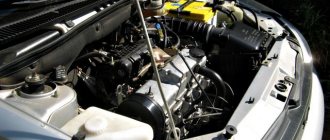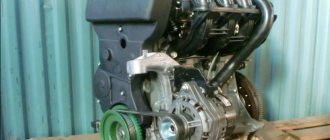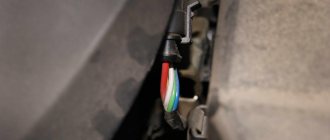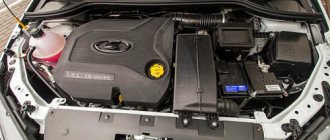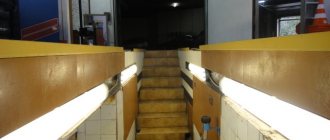The second generation Lada Kalina is an improved version of the Lada Kalina and incorporates the best developments of AvtoVAZ. In 2004, Kalina rolled off the assembly line for the first time, and since 2011, Lada Kalina has been the leader in sales volumes among passenger cars in Russia.
There have been no official tests for the media on the performance of the second generation Lada Kalina, so we will provide only preliminary characteristics. All this is in AvtoVAZ’s plans, and the numbers in the table may not be accurate.
Dynamic characteristics and fuel consumption figures are not yet known, but it has already become clear which engines, suspension and transmission will be used on Kalina 2.
Engine 2116 - for “norm” and “standard” configuration versions
The motor marked 2116 is installed on two types of equipment of the Lada Kalina 2 model. These are the “norm” and “standard” equipment. The engine is an improved version of the 11183 engine; the weight of the connecting rod and piston group set has been significantly reduced. Thirty-nine percent - engineers from Tolyatti did their best. The new version of this type of engine is better, for example, with a new camshaft drive, as well as a metal cylinder head gasket, and finally, an improved block air conditioning system. The main advantage of the latest engine model is also the mandatory heat treatment for the cylinder head. This makes the parts stronger and more durable.
All front-wheel drive Lada car models have an electric drive for the throttle valve in the engine. This engineering modernization added another ten to the number of horsepower of the engine. And now the engine has become ninety-horsepower. And due to the fact that the amount of mechanical losses was reduced, the engine torque also increased by 20 units. But it can be achieved already at 3800 rpm. Fuel consumption was also greatly reduced - which affected the increased environmental friendliness of the car. Less carbon dioxide emissions into the air.
The manufacturer assures customers that the car will travel at least 200 thousand kilometers before the first major overhaul. Also, the belt should last the same amount of time when paired with a new engine model.
Specifications
So, Kalina VAZ 11183 is a 5-door C-class sedan with 5 seats. Engine capacity - 1.6 l (petrol). Fuel is supplied evenly through the injection system. The drive is front-wheel drive, although initially the manufacturer relied on rear-wheel drive, but later completely abandoned it in favor of a more maneuverable car. The gearbox is mechanical, with the possibility of upgrading to an automatic (not in factory conditions). Fuel consumption in the combined driving cycle (highway and city) is about 7.2-7.5 liters. The ground clearance is quite high - 160 mm, but it should be understood that the car was not designed to set speed records. Moreover, the fuel tank here has a volume of 50 liters. This initially indicates that the vehicle is intended for long trips.
When talking about the technical characteristics of this car, it is necessary to mention that it uses a wide wheelbase (1670 mm). Lighting - fog and adjustable (with the ability to install LED lights) headlights. At one time, these functions were considered new, so it is not surprising that buyers quite readily accepted the idea of innovation from AvtoVAZ.
As for the technical characteristics, all that remains to be said is that the car uses a McPherson front suspension, which performed quite positively during the test drive. It does an excellent job of absorbing vibrations from small potholes and responds very smoothly to rough driving. The rear suspension is standard - a straight lever, which is already traditional for the Lada company.
The manufacturer provides for the installation of wheels with the following diameters:
- R13;
- R14.
For the “Lux” configuration there is a motor 21126
1.6 liters and almost a hundred horsepower - these are the characteristics of this engine. This became the second engine for the Lada Kalina 2. It is available only for the “richest” versions of the car. Here, too, the connecting rod and piston group have been lightened, as well as the hydraulic valve tappets. And there will be neither few nor many of them - four pieces for each cylinder. The new engine model, like the previous one, has a so-called “Gates” belt. The guarantee for such a belt is 120 thousand kilometers of road surface. Basically, all 200 thousand are subject to its resource. This belt has been tested with great success on the Lada Priora model.
Characteristics of the internal combustion engine VAZ 11183
| Characteristics of VAZ internal combustion engine | 11183 | 11183-50 |
| Serial production period, years | 2004-2017 | 2011-2017 |
| Type by cylinder arrangement | In-line (cylinders in 1st row) | |
| Cylinders | four | |
| Valves | eight | |
| Working volume, cm³ | 1596 | |
| Diam. cylinders, mm | 82 | |
| Piston stroke, mm | 75.6 | |
| Cylinder operating order | 1→3→4→2 | |
| Fuel supply | Injection, from four injectors in the intake manifold | |
| Intake manifold (receiver) | made of plastic, electronically controlled throttle body | |
| An exhaust manifold | together with the catalyst | |
| Max. power, hp | 80 | 82 |
| Max. torque, Nm | 120 | 132 |
| Compression ratio | 9.6 — 9.8 | 9.8 — 10 |
| Fuel type | AI 92-95 | |
| Amount of oil in the lubrication system, l | 3,5 | |
| Oil used in internal combustion engines | 5W-30, 5W-40 | |
| Gearbox oil filling volume, l | 3 | |
| Oil used in gearbox | 75W80, 75W90, 80W85, 80W90, 85W90 | |
| Environmental standards | EURO 2/3 | EURO 4 |
| Application on VAZ cars | Kalina, Granta, 21101, 21112, 21121, 2113, 2114, 2115. | |
| Resource, km | 150 000 | |
| Weight, kg | 112 |
Updated prioromotor with index 21127
Togliatti decided to update the existing engine 21126 and add a little fire to it - now Kalina 2 with such a “heart” will have a power of 106 horsepower, with a maximum torque of 150 N*m. This was achieved by adding different intake modes - at low speeds the air passes through a long channel, at high speeds through a short one. The engine also has a new absolute pressure sensor and updated software.
True, as with everything, there are some disadvantages - when the timing belt breaks, the valves wrinkle and the connecting rod and piston group of parts suffers.
Pros and cons of power units of different models of the family
Each Lada Kalina engine has its own immediate advantages and disadvantages. Positive aspects of model 11183:
- a time-tested engine (problems can be fixed at any car service center, spare parts are widely available);
- excellent traction, even when climbing uphill;
- A broken timing belt does not threaten the need to replace pistons and valves.
Negative aspects of model 11183:
- valve adjustment must be carried out with enviable regularity;
- the factory does not install air conditioners on this model;
- noise and vibration (hum, like from a diesel unit).
Motor with serial number 11194
Motor with serial number 11194. Pros:
- silent operation;
- the most economical gasoline consumption;
- there is no need to adjust valves, change oil and filters on schedule;
- good dynamics indicators.
Disadvantages of series 11194 motors:
- after 50,000 km the oil begins to be consumed;
- replacement of valves and pistons when the timing belt breaks (the piston system is quite scarce).
And finally, the last contender. Power unit number 21126. Advantages:
- silent operation;
- the best dynamics, the most powerful engine;
- There is no need to adjust the valves, only routine maintenance.
There is only one drawback: repair of valves and pistons in the event of a broken timing belt. Rarely is there continuity from the 11194 series in excessive oil consumption after 3-4 years of service.
How to adjust the valves?
The main question is how to adjust the valves. To perform this procedure, the owner will need to acquire the following set of tools, accessories and consumables:
- screwdrivers and pliers with long jaws;
- heads for unscrewing bolts;
- ratchet;
- a set of probes;
- crank;
- a syringe to remove excess oil from the head baths;
- tweezers for removing washers;
- adjusting washers of different sizes (thickness) and a device for recessing the valves.
Before the valve adjustment begins, let the engine cool down (temperature no more than 20 degrees).
- Don't forget about safety and remove the terminals from the battery.
- Remove the valve cover with gasket.
- During the procedure, you will need to rotate the crankshaft of the Lada Kalina. To facilitate this action, it is recommended to unscrew the spark plugs, having first removed the tips of the high-voltage cables from them.
- Remove the timing cover.
- Use a syringe to remove the remaining oil from the baths.
- We install the device for recessing the valves on the mounting studs of the motor cover and secure it with standard nuts.
- By rotating the crankshaft (with a key on the pulley bolt or a wheel with 5th gear engaged in the box, after hanging the side of the car), we achieve the TDC position in the 1st cylinder (the rightmost one in the direction of the car).
- From this position, turn the camshaft to an angle of 40-50 degrees (three pulley teeth).
- Using a feeler gauge, we measure the size of the gap between the back surface of the cams and the washers of the 1st (exhaust) and 3rd (intake) valves (we count from the shaft drive gear). The feeler gauge should fit into the gap with a slight “tightness”.
- When the gap size differs from the required value, the pusher should be turned so that its groove is opposite the “adjuster”.
- Using the device, we recess the valve, securing the pusher from turning using a screwdriver (insert it into the groove). Using the latch, we lock the pusher in its lower position.
- We remove the washer using the previously indicated tweezers.
- Read the markings on the washer. It indicates thickness. If the inscription is erased, measure with a micrometer.
- We calculate the required thickness of the washer to be installed using the well-known formula, which, by the way, is different for intake and exhaust valves.
- We select a new washer from the set, with a thickness close to the value obtained in the calculation (deviation - plus 0.05 mm).
- We install the selected washer in the seat (in the pusher). In this case, the surface with the markings should be facing down.
- Having pressed the pusher with the device (drowning it deeper), we remove the latch.
- Now we move on to adjusting the next pair of valves. To do this, we rotate the crankshaft to an angle of 220-230 degrees and carry out the entire list of previously indicated adjustment actions with the valves: 5th (exhaust) and 2nd (intake).
The manipulation algorithm for the two remaining pairs of valves, depending on the angle of rotation of the crankshaft in the Lada Kalina car, is as follows:
- angle of 400-410 degrees: 8th valve (exhaust) and 6th (intake);
- rotation angle of 580-590 degrees: 4th (exhaust) and 7th (intake).
To be sure that the adjustment is correct, you can re-perform the entire shaft rotation cycle with a control measurement of the gap values. Note that their value for the exhaust group of valves is 0.3 mm, and for the intake valves – 0.2 mm.
Review of Auto VAZ Kalina sedan
Lada Granta 87 l fuel consumption
A brief overview of the VAZ Kalina sedan with a 1.6 engine...
Hello dear readers of the blog RtiIvaz.ru. Today I want to talk to you about the VAZ Kalina car, in our version - a sedan, 1.6 - liter engine with 2 valves per cylinder. The car is equipped from the factory with 14-inch tires, an average configuration, which also includes electric power steering, an on-board computer and an immobilizer. Literally followed by a VAZ Kalina car with air conditioning. Kalina's exterior is made without any flashy elements, everything is done in a calm business style that fits into the concept of modern cars. The developers thought about optics, in which there are two lamps, separately for high and low beam. And the optics of the Kalina car vases themselves leave a pleasant impression, especially shimmering in the sun; by the way, the rear lights leave the same impression.
The trunk is quite spacious, measuring 400 liters, and the folding rear seats further increase the trunk volume. In addition, a well-thought-out solution for attaching the trunk lid, the hinges of which do not go inside the trunk, but fold into a special niche. This is very convenient when the trunk is fully loaded, since the absence of hinges inside allows you to use more space.
The trunk lid of the VAZ Viburnum car fits very tightly and, thanks to a reliable seal, protects from any, even pouring rain. Sometimes it happens that when loading objects with sharp edges carelessly, the seal is damaged, which breaks the tightness of the connection and allows moisture to penetrate. This nuisance in Kalina can be easily eliminated.
The doors are also perfectly fitted, which, by the way, open to a large angle, which is very convenient when boarding, especially for tall people. Kalina's rear lights are equipped with fog lights, there are stop repeaters, and a reversing light is mounted in both lights, which helps with night parking. It is worth noting that in Kalina cars, they have a very bright light, and this significantly gives confidence at night, when reversing.
The tires have a standard running size (175/65 R14), which eliminates problems when replacing them. If there is anything that will make you worry when looking for components, it is the wipers. The driver's wiper is much longer than the passenger's and there are few such options yet.
The engine behaves perfectly right from the start, showing good throttle response and as long as there are no more than three people in the car, the driver does not experience any problems. If the car is loaded and there are more than three people in the cabin, a factory limitation is felt, which can easily be reconfigured by flashing the ECU of the Kalina car.
The gear shift stroke is short; when you engage reverse gear, you need to lift the rocker, which, by the way, will be accompanied by a sound signal. The signal disappears after turning off the reverse gear.
In the urban cycle, the average consumption is 8.2-8.8l/100 km, outside the city 6.4l/100 km, after flashing the ECU - in the city - 7.8 - 8.2, on the highway - 5.5 - 6.2, and besides, VAZ Kalina cars have become noticeably faster.
You can also check out other materials:
There are several types of drive belts
Lada Granta – trial acquaintance
Lada 2107 – injector
Volvo C30 Electric – the future is near
Select the size of the seal yourself
Features of the 8-valve engine
A regular 8-valve engine, tested and easily repaired both in the service and in garage conditions.
Each cylinder has two valves, for intake and exhaust respectively. For a standard four-cylinder engine there will be 8 such valves.
The advantages of such a motor are as follows:
- Simplicity of design . 8-valve engines are time-tested. Compared to its 16-valve counterpart, there are fewer mechanical parts, and accordingly, repairs and maintenance will be cheaper. In addition, the absence of hydraulic compensators contributes to simplifying the design. Mechanical pushers are installed here, which are also cheap to replace and repair.
- The engine is undemanding to the quality of oil . You can use semi-synthetic lubricant.
- You can use 92 gasoline without loss of power.
- Compact dimensions , since there is only one shaft at the top. Accordingly, it will be easier to get to the starter, generator and attachments.
The old 8-valve engine is not plug-in (if the valve belt breaks, the valves do not meet the pistons). It's a pity that VAZ stopped producing it in 2012.
The disadvantages of such motors include:
- Low power . Since intake and exhaust are slower than with a 16-valve engine, it will not be possible to achieve similar speeds here.
- Increased fuel consumption . Again attributed to the slow intake-exhaust cycle.
- Relatively high noise level . This is especially true at speed. In addition, mechanical pushers require periodic adjustment. As a result of wear, gaps appear on them, causing additional noise and reducing efficiency.
- The need for more frequent valve clearance adjustments. This is necessary to prevent overspending.
Adjusting valves, in principle, is not a particularly complicated procedure, but it requires the presence of the necessary equipment and “heels”, which you usually don’t have in your garage.
For USA
restyling, 1st generation, 01.2000 - 01.2002, Jeep/SUV 5 doors.
| Equipment | Release period | Price | Engine make | Body brand |
| 2.5 l, 165 hp, Gasoline, manual transmission, all-wheel drive (4WD) | ||||
| 2.5MT Base | 02.2000 — 01.2002 | EJ251 | SF6 | |
| 2.5MT L | 02.2000 — 01.2002 | EJ251 | SF6 | |
| 2.5MT S | 02.2000 — 01.2001 | EJ251 | SF6 | |
| 2.5 l, 165 hp, Gasoline, automatic transmission, all-wheel drive (4WD) | ||||
| 2.5 AT L | 02.2000 — 01.2002 | EJ251 | SF6 | |
| 2.5 AT S | 02.2000 — 01.2001 | EJ251 | SF6 |
1st generation, 02.1997 - 01.2000, Jeep/SUV 5 doors.
| Equipment | Release period | Price | Engine make | Body brand |
| 2.5 l, 165 hp, Gasoline, manual transmission, all-wheel drive (4WD) | ||||
| 2.5MT Base | 06.1997 — 01.2000 | EJ25D, EJ251, EJ253 | SF6 | |
| 2.5MT L | 06.1997 — 01.2000 | EJ25D, EJ251, EJ253 | SF6 | |
| 2.5MT S | 06.1997 — 01.2000 | EJ25D, EJ251, EJ253 | SF6 | |
| 2.5 l, 165 hp, Gasoline, automatic transmission, all-wheel drive (4WD) | ||||
| 2.5 AT L | 06.1997 — 01.2000 | EJ25D, EJ251, EJ253 | SF6 | |
| 2.5 AT S | 06.1997 — 01.2000 | EJ25D, EJ251, EJ253 | SF6 |
Engine assembly EJ20 for Subaru Price 44,000 rub.
Automatic transmission Subaru Legacy Lancaster bh9 Price 25,000 rub.
Bumper Subaru Forester sg5 S11 restyle Price 12,000 rub.
Front bumper Subaru Forester (S10) 1997-2002 Price 9,000 rub.
Left headlight Subaru Forester (S11) 2002-2007 Price 7,000 rub.
Wing/quarter rear right Price 18,000 rub.
Summing up
It is quite difficult to unequivocally answer the question which engine is better.
If you are interested in power, quick acceleration and quiet driving, then it is better to choose a 16-valve engine. It consumes less gasoline and does not require valve adjustments.
If low maintenance and unpretentiousness are important to you, then your choice is an 8-valve engine . This option is better suited for those motorists who prefer to maintain and repair their car themselves.
Increased pressure
A paradoxical situation with increased compression occurs when motor lubricant enters the piston rings from above, from the side of the combustion chamber. It seals the interface and when measured the pressure surge reaches 14-15 bar.
Cause. in worn valve seals, which provide a lot of lubricant to the Niva’s combustion chamber. The exhaust fumes are desperate, the oil consumption is high, but the pistons and rings have nothing to do with it. The fault is detected when the valve cover is opened and the tappets are removed from the valves. Unsuitable caps are “oaky” to the touch or covered with cracks. Oil seals can be changed without disassembling the power unit.
